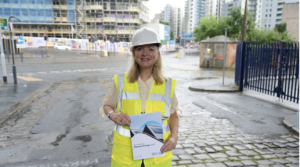Long read: the three principles of place-based change
 The Big Local programme is proving the power of small actions in neighbourhoods that are low on confidence. But history shows that such places also need reliable public services, as Julian Dobson reports in this new essay
The Big Local programme is proving the power of small actions in neighbourhoods that are low on confidence. But history shows that such places also need reliable public services, as Julian Dobson reports in this new essay
In Joseph Heller’s famous second world war novel, Catch-22, a bomber pilot, Orr, faces the dilemma of putting his personal safety at risk every time he gets in his plane. Continuing to do so would prove he was insane and therefore not fit to fly. But refusing to fly would show he was sane, and therefore he had to keep flying.
Look at the history of government policy on distressed and deprived neighbourhoods and you might identify a similar Catch-22. The worse off and more troubled your area is, the more pressure you face to mobilise your own resources to change things. But the more successful you are at mobilising your own resources, the less likely you are to get help from outside.
It is, of course, never intentional. But rhetoric of empowerment and self-help has often been accompanied by an assumption that external assistance will be scaled back as communities deal with the problems they face. Funds are allocated with an agenda of ‘pump priming’ or ‘sustainability’: a view that a little help will result in long term, lasting change.
At a time when public services are financially challenged, sometimes the arrival of help from one source becomes an excuse to withdraw support from another. Some Big Local projects are already finding this. An interim evaluation of Big Local found ‘concerns that Big Local is picking up the pieces from the cuts in public services’. This was a particular challenge where non-statutory services such as youth activities were being cut.
Last year I was commissioned by the Local Trust, which funds 150 neighbourhood-scale Big Local projects across England, to consider the achievements of Big Local projects in the context of a long history of self-help and mutual aid. The Big Local idea is radical, involving a genuine effort to put residents in charge and tailor funding – £1 million for each project over ten years – to local priorities. My report, an extended essay focusing on the work of three Big Local schemes and three historical examples, was published earlier this month.
My research sought to explore how relatively small scale grants, sustained over a decade and given light-touch support – ‘on tap, not on top’, as the saying goes – can make a lasting difference. The differences highlighted in the three Big Local projects featured are modest but significant.
They are especially significant for the individuals at the heart of Big Local, and for a range of households they come into contact with; but also for the communities that benefit from new facilities such as play areas at Birchwood in Lincoln, environmental improvements at Brookside in Telford, or events that bring isolated people and communities together, such as firework displays and an outdoor cinema in Netherton, on the border of Sefton and Liverpool.
Local Trust’s vision is that every area it works with should be ‘resilient, confident and a good place to live’. Its core belief is that resident-led action develops local skills and confidence, builds on each community’s skills and assets, and creates long-term, lasting solutions. There is no doubt, from the visits to Big Local projects described in my research and from the ongoing evaluation, that skills and confidence are being developed and that projects are building on local assets.
However, it’s worth unpacking the notion of resilience. There are many ways of thinking about resilience, from the ability to ‘bounce back’ in the face of a crisis, to a more forward-looking vision that concerns an ability to adapt and evolve. At a community level, though, it has tended to be attached to notions of ‘getting by’ as resources, both local and external, diminish. A study in Northern Ireland found that residents of poor communities felt being resilient was about ‘enduring, surviving, just ‘getting on with things’, and ‘keeping heads above the water’.
Another study in Sheffield warned that resilience ‘is a strategy for helping communities cope with adversity, rather than overturning structural inequalities. It can help communities to ‘beat the odds’, but it cannot “change the odds” by removing the causes of adversity’.
The Sheffield study identified four ingredients that helped some communities manage adversity better than others: ‘gathering places’ or community venues where people could get together; a sense of belonging ‘rooted in common interests and experiences’; information sharing at a local level, and a ‘community voice’ that could be heard beyond the neighbourhood; and a combination of passionate individuals and local amenities and facilities that could provide a base for activities.
The Sheffield study also highlighted a fifth essential ingredient. It observed: ‘Even resilient communities will continue to require the support of public services to mediate the impact of stressors and support the on-going development, engagement and realisation of collective capacity.’ This is an increasing challenge in Big Local areas.
So we must ask how the vision of localities that are ‘resilient, confident and a good place to live’ connects to long-term change: how can these become thriving, flourishing communities?
To consider the possibilities, we might pose a range of scenarios. They are speculative, but not imaginary: they are based on previous experience of place-based initiatives.
Scenario 1: Reweaving the fabric
Possible model: Goodwin Development Trust, Hull.
In this scenario, the work of Big Local projects is supported and continues beyond the completion of Big Local itself. The priorities remain broadly similar: building community skills and confidence, mostly through small-scale and highly personal interactions, initiatives and events. The principle of resident leadership remains. Over time, new volunteers are recruited and trained; some of the original participants build the confidence to start projects and initiatives of their own; a rich web of local activity develops, supported and promoted through a neighbourhood hub where voluntary groups and statutory services come together, discuss issues of mutual concern and complement each other’s work.
Scenario 2: Building local assets.
Possible model: Coin Street Community Builders, London.
Recognising that funds from statutory services cannot be guaranteed, community leaders or development charities create their own funding streams. They might do this through community owned housing, acting as a landlord and reinvesting rent surpluses; by operating social enterprises that create employment or reinvest in the local community; or by renting out shops and business premises. The income stream funds services such as community centres and youth clubs that might otherwise be closed or neglected. However, there are risks. An income stream can quickly turn into a loss-making business.
Scenario 3: Alternative enclaves.
Possible model: Isle of Eigg Heritage Trust.
The most radical version of the self-help model is for a community to take over entirely: to own the land and housing, to run its own services, and to organise itself democratically. The Isle of Eigg in the Western Isles of Scotland, bought by the local community in 1997, is a step in that direction. Its remoteness means that people have to devise their own solutions; the heritage trust now runs its own renewable energy grid, operates a multi-purpose community centre and is restoring the island’s natural environment. But its small scale and remoteness make it an exceptional case.
Scenario 4: Perpetual regeneration.
Possible model: Broadwater Farm estate, Haringey.
A succession of local initiatives mitigates, but does not address, deep-seated social and economic challenges. For some public servants the aim is to contain and control difficulties, not to support and build people’s lives. Infrastructure and improvements achieved in partnership with local residents are put at risk by the next big idea. There is recurring talk of large-scale redevelopment, leaving residents feeling threatened and vulnerable.
Scenario 5: Institutionalised neglect.
Possible model: abandoned neighbourhoods of the 1990s.
In this scenario, areas characterised by poverty and low economic activity are put in the ‘too difficult’ folder. While small-scale local initiatives may take place and some dedicated public servants work closely with local communities, the major public service organisations turn their attention elsewhere or imagine the slate can be wiped clean through demolition and redevelopment. Lessons from previous projects and programmes are filed and forgotten. The stigma of the ‘sink estate’ becomes a self-fulfilling prophecy, created through the negligence of public bodies, perpetuated by national and local media, and blamed on local residents.
These scenarios are all possible, to different degrees in different neighbourhoods. With the exception of the Eigg model, each one is predicated on a set of relationships, healthy or toxic, between local residents and the statutory services operating at a local level. Self-help and mutual aid are often described as alternatives to the provision of public services, and can arise in opposition to the activities of statutory bodies or to fill gaps that official agencies have left. But they do not exist in a vacuum: their success and impact is intertwined with the success and impact of local services.
There is a paradox at the heart of Big Local that must be embraced if its effects are to last and be magnified. That is that the greater the change local people want to see, the more robust the everyday infrastructure must be that enables such changes to take place. Big Local will work best when it complements improvements in local services, not when it is seen as an alternative to them.
Based on learning from previous programmes, three central principles emerge. None of them are new or radical, and most will seem obvious. The challenge is making them stick.
Principle 1: Invest in everyday infrastructure. Localities require a core level of basic services, consistently funded and at a scale that provides reliability, accountability and adaptability. At a minimum these should include decent housing, environmental services such as rubbish disposal and open space maintenance, primary healthcare, education and vocational training, and the provision and maintenance of ‘third spaces’ that enable communities to come together and initiate activities. These need to be supported by a tax and benefits system that ensures nobody goes without life’s essentials.
Principle 2: Support local initiative. Create the conditions for local flourishing by promoting self-organisation and mutual aid. This includes supporting and respecting local leaders; providing resources and freedom, as Big Local does, to allow communities to set their own agendas and meet local needs as they see fit; providing learning and networking opportunities; and making public services responsive to community needs through localisation and neighbourhood-based management rather than through centralisation and digitisation.
Principle 3: Take the long view. Change is an evolutionary process, not a succession of projects. There are no fixes; local interventions should be thought of not as solutions to problems, but as ways of building and maintaining the capacity to respond to ever-evolving challenges. Trust and respect grow over time, but can be quickly destroyed by officials and politicians determined to see through short term visions for ‘transformation’. Slow policy may be the best policy.
Perhaps the most significant lesson of Big Local, particularly in the context of the last few decades of British public policy, is that we shouldn’t underestimate the importance of well-tested and unsurprising ideas. Community initiatives have been beset by institutional amnesia and reinventing wheels. Sometimes we don’t need new wheels: we just need to lubricate the ones we have and replace the tyres before they wear out.
Big Local has shown the power of small actions and modest radicalism. Big Local neighbourhoods show that long-term investment and respectful support can go a long way. Neighbourhoods that are low on confidence need this kind of slow and sustained assistance.
But they also need reliable, effective, consistent and responsive public services. Big Local and similar approaches can help identify the seeds beneath the snow, and can plant new ones. But successful germination and sustained growth may require a bigger change in the weather.
- This is an edited version of the final chapter of New Seeds Beneath the Snow?, an extended essay by Julian Dobson commissioned by Local Trust and available at https://localtrust.atavist.com/new-seeds
















Great piece, Julian.
Thanks for these thoughts, every one of which resonates with my 25 years experience in Deptford and Hastings and my wider knowledge of neighbourhoods (and ‘regeneration’) all over the country.
I just wonder if we’re giving up too soon on the Eig model for all but the most remote areas. Just as community land trusts, which began as rural responses have been successfully adapted and are rapidly evolving in urban contexts, perhaps there is inspiration in the Highlands that could spark radical self-provision in other kinds of neighbourhoods?